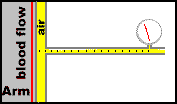|
The sphygmomanometer (sss-fig-no-ma-nom-eter) is a simple device used to measure your blood pressure. It uses compressed air as a hydraulic fluid to transmit the force of your pulsing blood. Here's how it works. Ordinarily, air cannot be used as a hydraulic fluid, because it will compress. However, if you compress the air first, so that it won't easily compress much more, air will act much like water or oil ... it will push things with great force. The force of this squeeze is transmitted through the compressed air, up the tube and into the meter. The reason the force can be transmitted up the tube is because the air is compressed ... it acts just like a liquid. It transmits the force.  In the diagram at the right, the pulsing artery pushes on the air (yellow) in the sphygmomanometer, and this force is transmitted by the air to the meter.
It's just like squeezing one end of a tube of toothpaste; the cap will pop off the other end. In this case, the needle on the gauge moves, proportionately to the amount of force from the pulsing blood. In the diagram at the right, the pulsing artery pushes on the air (yellow) in the sphygmomanometer, and this force is transmitted by the air to the meter.
It's just like squeezing one end of a tube of toothpaste; the cap will pop off the other end. In this case, the needle on the gauge moves, proportionately to the amount of force from the pulsing blood. |